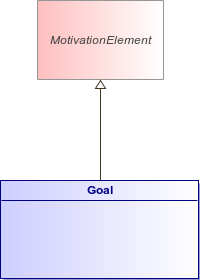
ArchiMate Metamodel
In principle, a goal can represent anything a stakeholder may desire, such as a state of affairs, or a produced value. Examples of goals are: to increase profit, to reduce waiting times at the helpdesk, or to introduce online portfolio management. Goals are typically used to measure success of an organization.
Goals are generally expressed using qualitative words; e.g., "increase", "improve", or "easier".
Goals can also be decomposed; e.g., Increase profit can be decomposed into the goals Reduce cost and Increase sales. However, it is also very common to associate concrete outcomes with goals, which can be used to describe both the quantitative and time-related results that are essential to describe the desired state, and when it should be achieved.
Refinment and equivalence link
An Archimate goal may be refined in an Analyst goal. The Archimate goal may then be set as equivalent as the Analyst one. Then, the Archimate goal will be synchonized to the Analyt one, calling getName() or setName() on the Archimate goal will call the same method of the Analyst one.

Attribute | Description |
|---|---|
string equivalentRef [1..1] | To set this goal as equivalent to an analyst Goal, set this attribute with the result of new MRef(analystElement).toString(). |